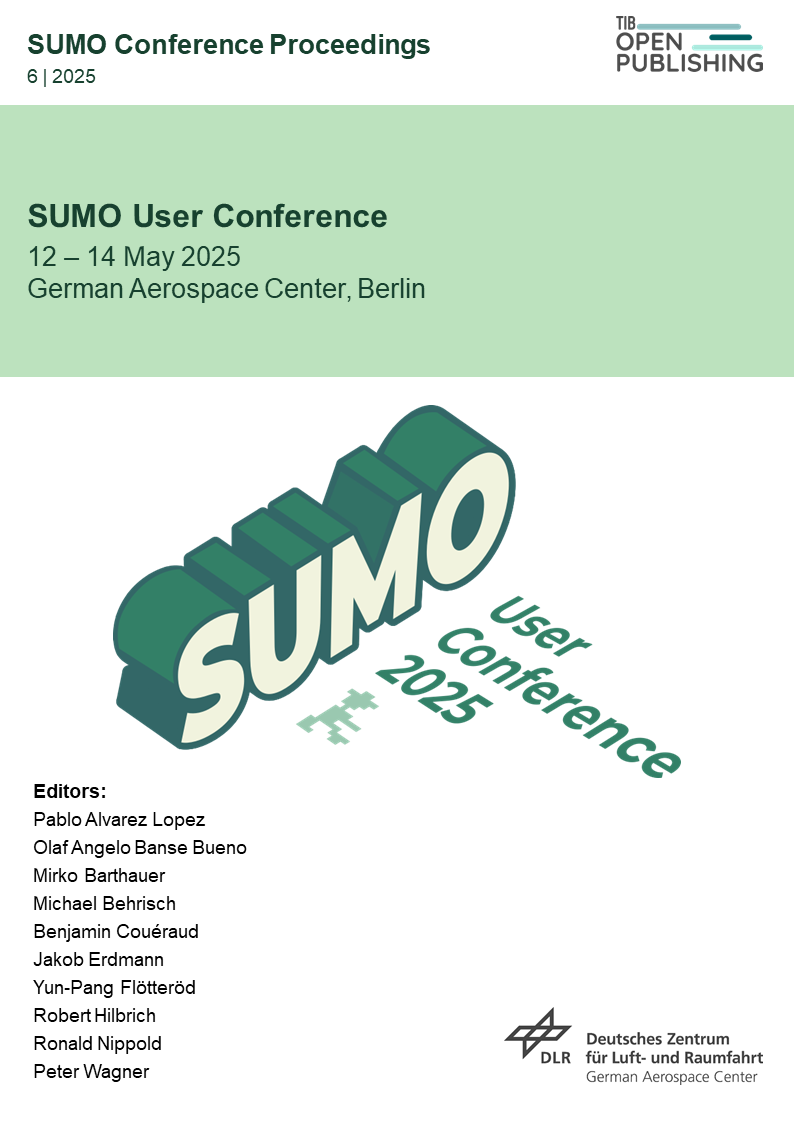SUMO in SPACE: Combining SUMO and dSPACE for Advanced Traffic Simulation
DOI:
https://doi.org/10.52825/scp.v6i.2617Keywords:
SUMO, dSPACE, Co-Simulation, Microscopic Simulation, Submicroscopic SimulationAbstract
Microscopic traffic simulation tools enable the simulation of various traffic demands and their impacts. By implementing realistic traffic models, they are commonly used to analyze traffic engineering measures. Since microscopic traffic simulations focus more on the network than on individual small-scale scenarios, such frameworks are appropriate for efficiency studies. In this respect, SUMO allows only a limited investigation of efficiency measures at the vehicle level, as the underlying vehicle models, such as Krauss, Gipps, or IDM, do not regard vehicle dynamics constraints. To encounter this disadvantage, SUMO is enriched by the elements of the submicroscopic simulation tool ASM from dSPACE, including a highly detailed vehicle dynamics model for the ego vehicle. Combining the elements of microscopic and submicroscopic simulation in a co-simulation framework, the effectiveness assessment of efficiency measures can be broken down to vehicle level. Besides the efficiency aspect, the proposed co-simulation bridge also offers the possibility to simulate sensing technology in a 3D environment with AURELION, where SUMO provides realistic traffic situations.
Downloads
References
M. Behrisch, L. Bieker, J. Erdmann, and D. Krajzewicz, "SUMO–simulation of urban mobility: an overview", in Proceedings of SIMUL 2011, The Third International Conference on Advances in System Simulation, 2011.
C. Stang, and K. Bogenberger, "Calibration of Microscopic Traffic Simulation in an Urban Environment Using GPS-Data", in SUMO Conference Proceedings, vol. 5, 2024, pp. 71–78. DOI: 10.52825/scp.v5i.1099.
M. Pechinger, and J. Lindner, "Sumonity: Bridging SUMO and Unity for Enhanced Traffic Simulation Experiences", in SUMO Conference Proceedings, vol. 5, 2024, pp. 163–177. DOI: 10.52825/scp.v5i.1115.
V. Punzo, and F. Simonelli, "Analysis and comparison of microscopic traffic flow models with real traffic microscopic data", Transportation Research Record, vol. 1934, no. 1, pp. 53–63, 2005. DOI: 10.1177/0361198105193400106.
E. Brockfeld, and P. Wagner, "Calibration and validation of microscopic traffic flow models", in Traffic and Granular Flow’03, 2005, pp. 67–72. DOI: 10.1007/3-540-28091-X_6.
dSPACE, "Automotive Simulation Models (ASM)", 2025. Accessed: Feb. 9, 2025. [Online]. Available: https://www.dspace.com/de/gmb/home/products/sw/automotive_simulation_models.cfm#176_26302.
A. Validi, N. Polasek, L. Alabi, M. Leitner, and C. Olaverri-Monreal, "Environmental Impact of Bundling Transport Deliveries Using SUMO: Analysis of a cooperative approach in Austria", in 2020 15th Iberian Conference on Information Systems and Technologies (CISTI), 2020. DOI: 10.23919/CISTI49556.2020.9141129.
L. M. S. Campoverde, and A. R. M. Caiza, "CO2 Emission and Fuel Consumption Effects in VANETs: a Simulation Analysis Using SUMO", in 2024 32nd Telecommunications Forum (TELFOR), 2024. DOI: 10.1109/TELFOR63250.2024.10819051.
J. Schweizer, C. Poliziani, and F. Rupi, "Simulating platooned connected autonomous vehicle in a large scale urban scenario", in SUMO Conference Proceedings, vol. 3, 2022, pp. 171–179. DOI: 10.52825/scp.v3i.175.
DLR, "Sumo User Documentation, Simpla", 2025. Accessed: Feb. 9, 2025. [Online]. Available: https://sumo.dlr.de/docs/Simpla.html.
K. N. Porfyri, E. Mintsis, and E. Mitsakis, "Assessment of ACC and CACC systems using SUMO", EPiC Series in Engineering, vol. 2, pp. 82–93, 2018.
L. Koch, D. S. Buse, M. Wegener et al., "Accurate physics-based modeling of electric vehicle energy consumption in the SUMO traffic microsimulator", in 2021 IEEE International Intelligent Transportation Systems Conference (ITSC), 2021, pp. 1650–1657. DOI: 10.1109/ITSC48978.2021.9564463.
M. Pechinger, G. Schröer, K. Bogenberger, and C. Markgraf, "Roadside infrastructure support for urban automated driving", IEEE Transactions on Intelligent Transportation Systems, vol. 24, no. 10, pp. 10643–10652, 2023. DOI: 10.1109/TITS.2023.3277138.
R. Coulter, "Implementation of the pure pursuit path tracking algorithm", Technical report, DTIC Document, 1992.
V. Lizenberg, M. R. Alkurdi, U. Eberle, and F. Köster, "Intelligent co-simulation framework for cooperative driving functions", in 2021 IEEE 17th International Conference on Intelligent Computer Communication and Processing (ICCP), 2021, pp. 109–115. DOI: 10.1109/ICCP53602.2021.9733618.
dSPACE, "ASM User Help and Documentation".
ISO, "ISO 15622: 2018-intelligent transport systems—adaptive cruise control systems—performance requirements and test procedures", ISO, 2018.
Downloads
Published
How to Cite
Conference Proceedings Volume
Section
License
Copyright (c) 2025 Christopher Stang, Dennis Roeser
https://creativecommons.org/licenses/by/3.0/de/deed.enAccepted 2025-04-25
Published 2025-07-15
